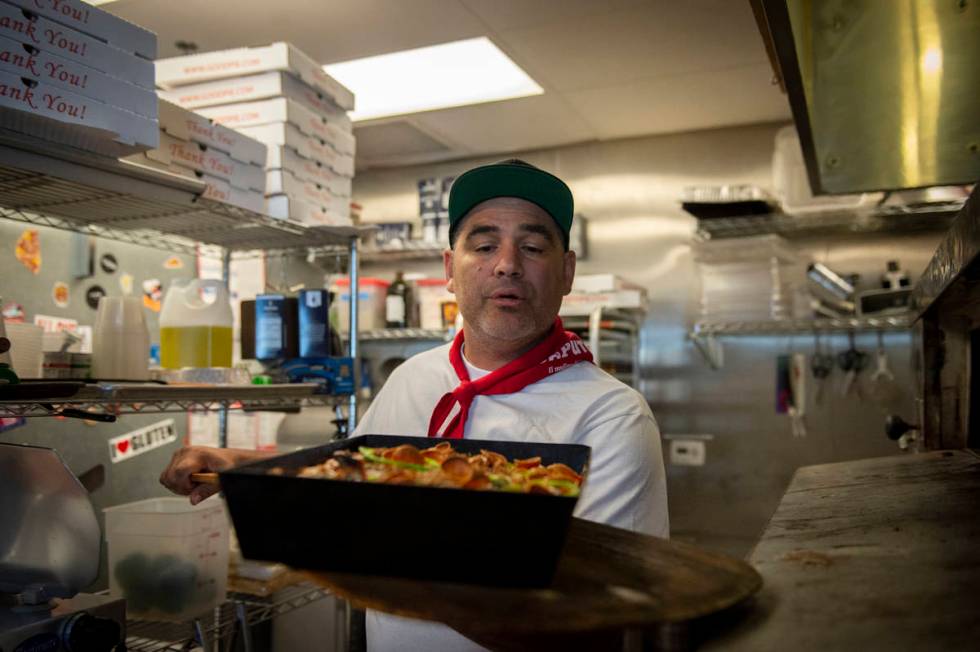Unable to seat diners, Las Vegas restaurants in survival mode

Ask a local chef or restaurateur about the mood in the industry these days, and the replies are discouragingly similar.
“The general feeling is an overwhelming sense of fear,” offers James Trees, who has stopped service at his Arts District restaurant Esther’s Kitchen as well as his Tivoli Village spot Ada’s, despite his initial impulses to carry on with limited service.
“Everybody is scared,” says Elizabeth Blau, who continues to operate her neighborhood restaurant Honey Salt, while her Strip operation, Buddy V’s in the Grand Canal Shoppes, is closed. “Everyone is terrified. Every time I walk into that restaurant, the cooks, the dishwashers, all these people are looking at me like: Is she coming to fire us? Is this our last day? People are absolutely terrified.”
Metro Pizza’s John Arena, a founder of the Vegas Pizza Alliance, concurs.
“The general vibe is fear.”
Some neighborhood restaurants have found creative ways to continue serving their communities, adopting curbside pickup and providing access to hard-to-find grocery items as supermarkets struggle to keep their shelves stocked. Some smaller family-owned restaurants even report business that’s comparable to pre-coronavirus levels. But, Blau is quick to note, the number of those businesses pales in comparison to those that have temporarily ceased operations.
“There are so few of us open anymore,” she says, “It’s an infinitesimal point. Most people have decided that the financial upside is negligible.”
Statistics seem to support that assessment. The Las Vegas-based Shift4 Payments, which processes 3.5 billion transactions annually for 200,000 businesses nationwide, reports that its Nevada restaurant transactions for the seven days prior to Thursday are down a staggering 96 percent compared with the week of Feb. 2.
In the pizza world, Arena says some businesses are better suited to weather this storm than others.
“The guys that have been doing takeout from day one, it’s not that big of a transition. People who have a product that’s not typically associated with takeout, like Neapolitan pizza for example, are struggling. It’s hard to make that transition. The guys that are casino-based are shut down. The places that are heavily dependent on dine-in are struggling to adapt.”
Even some of those well-positioned for the new curbside business model have decided it’s not worth staying open. At Good Pie in Pawn Plaza, Vincent Rotolo has temporarily shuttered after having one of his best weeks ever last week.
“In order for my room to run safely (with social distancing), I can only have two people. And we had too much business for two people to handle. And if I put three to four people in there, they were working too closely together, and I didn’t like that.”
Just as importantly, he says, he just wasn’t enjoying going to work in the current environment.
“I cook inspired by love and happiness,” he says. “That’s what inspires me to cook. And cooking during this time, I wasn’t enjoying it. For the first time in my life I didn’t want to make pizza. I didn’t want to do it.”
Trees says that by closing his restaurants now he believes he’ll be able to better position himself to serve the community in the long run.
“The trick is, are you going to be able to fight now, and serve a very small fraction of customers? Or are you going to save those resources for when you’re actually able to reopen, and really serve your community?”
He’s using this time to clean and renovate his restaurants, employing as many people as he can to do chores they hadn’t been able to make time for while he was open for business.
“I would rather take care of those people then, when we really know what the impact is going to be, than try to stay open and work at a significant loss over an unknown period of time.”
Contact Al Mancini at amancini@reviewjournal.com or 702-387-5250. Follow @AlManciniVegas on Twitter.